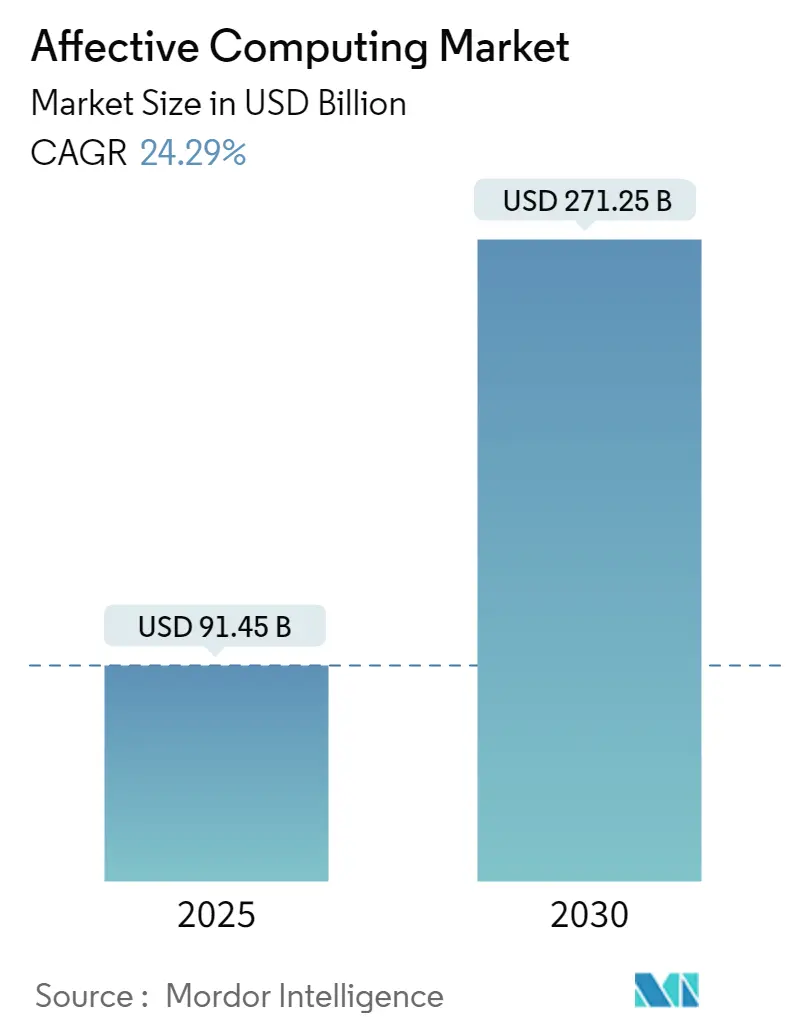
| Study Period | 2019 - 2030 |
| Market Size (2025) | USD 91.45 Billion |
| Market Size (2030) | USD 271.25 Billion |
| CAGR (2025 - 2030) | 24.29 % |
| Fastest Growing Market | Asia-Pacific |
| Largest Market | North America |
| Market Concentration | Low |
Major Players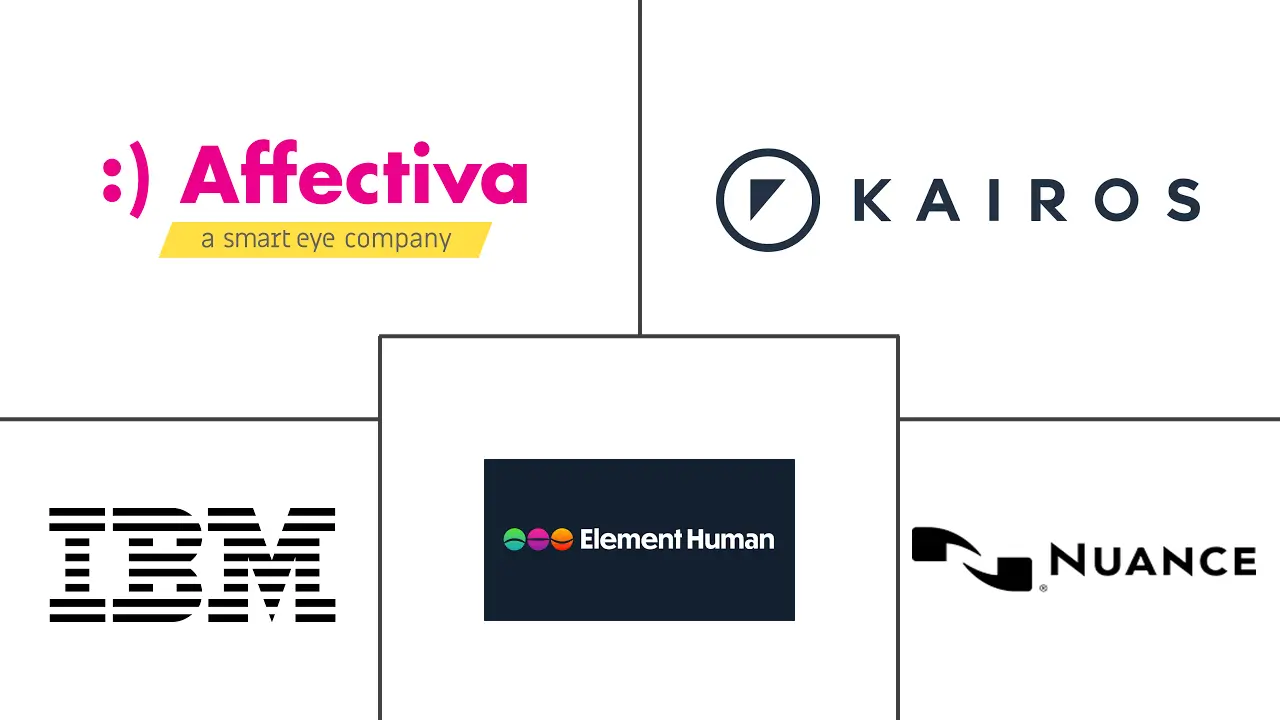
*Disclaimer: Major Players sorted in no particular order |
Affective Computing Market Analysis
The Affective Computing Market size is estimated at USD 91.45 billion in 2025, and is expected to reach USD 271.25 billion by 2030, at a CAGR of 24.29% during the forecast period (2025-2030).
The affective computing industry is experiencing a profound transformation driven by advances in computing capacity, improved communication technology, and breakthrough solutions in artificial emotional intelligence. This evolution has enabled the development of sophisticated systems capable of recognizing, interpreting, and processing human emotions across various applications. The technology's maturation is particularly evident in the robotics sector, where, according to the International Federation of Robotics (IFR), global industrial robot installations reached approximately 517,385 units in 2023, with projections indicating an increase to 690,000 units by 2025. This rapid robotics adoption is creating new opportunities for affective computing integration, particularly in developing socially intelligent automated systems.
The industry has witnessed significant advancements in practical applications, ranging from personalization systems to healthcare solutions. These applications include sophisticated prototypes like Gestele for speech-impaired individuals, emotion-responsive environmental control systems, and advanced security implementations utilizing voice-activated biometrics. The technology has evolved to support three critical business needs: process automation, data-driven insights, and cognitive customer engagement, with particular emphasis on creating more natural human-computer interactions that can understand and respond to emotional cues through emotion recognition.
Research and innovation continue to drive market evolution, with leading institutions making breakthrough discoveries in emotional AI applications. In August 2022, the MIT Media Lab's Affective Computing Research Group demonstrated empirical evidence that empathic computing machine learning can effectively mitigate negative impacts on human creative problem-solving, particularly in managing anger-related responses. This research represents a significant advancement in understanding how machine emotional intelligence can be practically applied to enhance human performance and well-being, opening new avenues for application across various sectors.
The market is characterized by increasing strategic partnerships between technology providers and end-users, focusing on data-driven development and comprehensive solution offerings. These collaborations are essential for overcoming technical challenges and advancing the practical applications of affective computing. The industry is witnessing a shift toward more sophisticated implementations that combine multiple technologies, including facial analysis, voice pattern recognition, and deep learning, to create more accurate and reliable emotion recognition systems. This integration of technologies is particularly crucial as organizations seek to develop more nuanced and effective ways to understand and respond to human emotional states through gesture recognition.
Affective Computing Market Trends
Increased Automation in Contact Centers
Contact centers are rapidly embracing affective computing technologies to enhance customer experience and operational efficiency through automated systems that can detect and respond to customer emotions. Modern contact centers are integrating communication application programming interfaces (APIs) to support newer channels like social media, mobile app chats, and video interactions, moving beyond traditional voice-only services. These automated systems can identify customers' emotional states through voice analysis, allowing service agents to better respond to stressed or emotionally charged situations and provide more personalized customer care. For instance, US-based Answer Connect implemented Amazon Connect's cloud-native solution that enabled seamless scalability based on call volumes while maintaining consistent operations.
The integration of automation in contact centers has expanded to include various applications that significantly improve customer interactions. Automatic speech recognition (ASR) has transformed how customers engage with interactive voice response (IVR) systems, enabling more effective self-service options. When agents interact with customers over the phone or chat, artificial intelligence technology supports them with suggested solutions and recommended responses based on emotional analytics. Companies like Automation Anywhere have introduced specialized solutions for contact centers, such as their cloud-native, AI-driven automation platform launched to help organizations deliver enhanced customer service more efficiently. These solutions enable contact centers to analyze customer sentiment in real-time, allowing for immediate adjustments to service delivery and more empathetic customer interactions.
Increasing Adoption of Cloud-based Solutions and Online Solutions
The widespread adoption of cloud-based solutions has become a crucial driver for affective computing implementation across various industries, providing the necessary infrastructure for emotional AI integration and data analysis. According to Logic Monitor, 81% of all enterprises have already implemented or are planning multi-cloud strategies, with projections indicating that 83% of enterprise infrastructure will be cloud-based by the end of 2023. This shift towards cloud computing has enabled businesses to implement sophisticated sentiment analysis tools without significant hardware investments, while also providing the scalability and processing power needed for complex affective computing applications. Healthcare organizations, in particular, are increasingly turning to cloud computing for document storage, marketing, and human resources, driven by digital consumer behaviors and the requirement for secure and accessible electronic health records (EHRs).
Corporate environments are witnessing substantial benefits from cloud adoption, particularly in implementing affective computing solutions that enhance productivity and operational efficiency. The cloud infrastructure provides the foundation for processing vast amounts of emotional data collected through various channels, enabling real-time analysis and response to user emotions. By enhancing productivity, eliminating the need for large security and maintenance teams, and reducing server space costs, enterprise cloud adoption leads to significant bottom-line savings while supporting the implementation of advanced affective computing capabilities. This technological convergence has enabled businesses to deploy emotion-aware applications that can analyze customer sentiment across multiple channels, providing valuable insights for improving service delivery and customer engagement strategies. Additionally, behavioral analytics and emotion detection are increasingly integrated into these systems to further refine the understanding of customer interactions and enhance service quality.
Segment Analysis: By End-User Industry
Retail Segment in Affective Computing Market
The retail segment dominates the affective computing market, commanding approximately 42% of the market share in 2024. Retailers are extensively leveraging emotional AI-powered computer vision technology to analyze demographic information and mood reactions of shoppers. The technology's deployment through small cameras and sensors in high-traffic locations such as shelves, checkout lines, and store entrances enables retailers to gauge shopper sentiment effectively throughout the customer journey. Major brands and retailers are partnering with emotion-based AI companies to build closer relationships with customers, implementing solutions that provide emotionally tailored personal recommendations and understand individual customers' emotional context. The retail sector's dominance is particularly evident in the apparel and fashion industry, where understanding consumer behavior through emotion recognition software and emotional technology has become crucial for designing garments, marketing strategies, and improving overall customer experience.
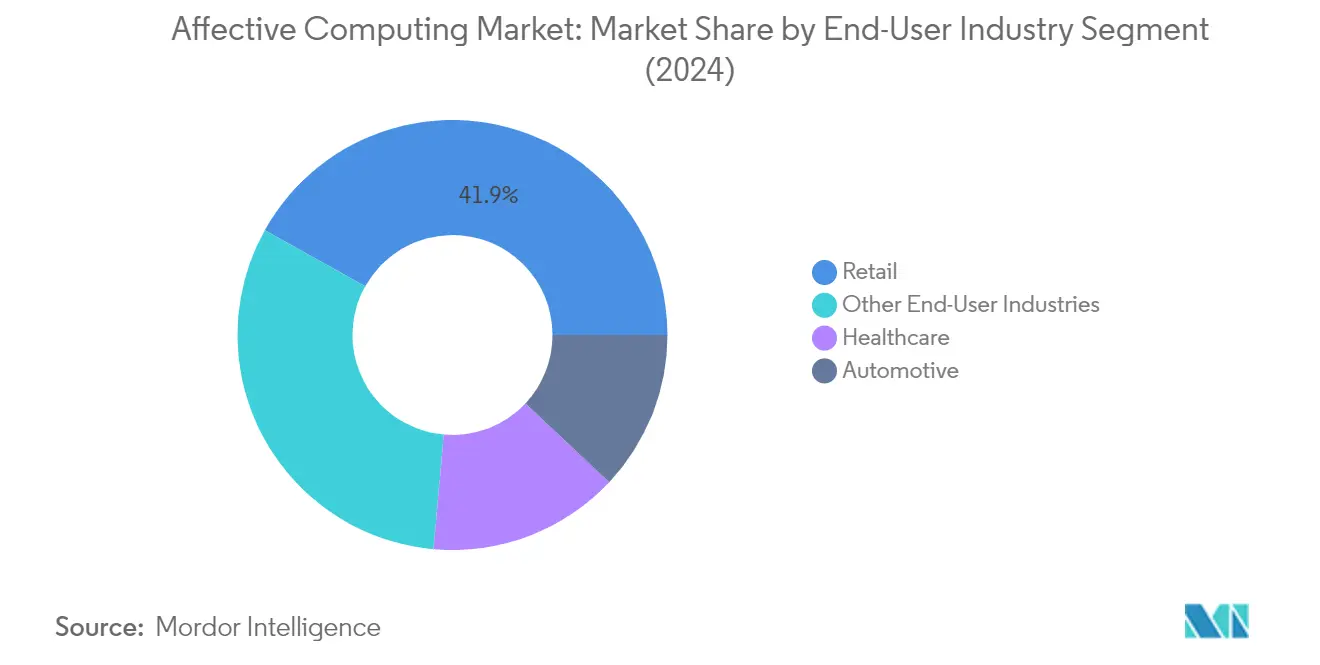
Automotive Segment in Affective Computing Market
The automotive segment is experiencing the fastest growth in the affective computing market, with an expected growth rate of approximately 32% during 2024-2029. This rapid expansion is driven by the increasing integration of advanced driver assistance systems (ADAS) and in-cabin monitoring solutions. Automotive manufacturers are incorporating sophisticated emotion sensing technologies to enhance driver safety by monitoring drowsiness, attention levels, and overall emotional state. The segment's growth is further accelerated by the development of AI-powered systems that can detect and respond to driver behavior, enabling features such as drowsiness alerts, posture monitoring, and smart seat adjustments for improved passenger comfort. The implementation of these technologies is also being driven by stringent safety regulations and the industry's push toward more intelligent and responsive vehicle systems.
Remaining Segments in End-User Industry
The healthcare and other end-user industries segments continue to play vital roles in shaping the affective computing market landscape. In healthcare, affective computing technologies are being deployed to assist in patient care, particularly in mental health monitoring and treatment of conditions such as autism and epilepsy. The technology is also finding applications in remote patient monitoring and emotional state assessment during therapeutic sessions. Other end-user industries, including gaming, education, and banking, are increasingly incorporating multimodal emotion recognition and biometric sensing solutions to enhance user experience and improve service delivery. These sectors are leveraging emotion recognition capabilities to create more personalized and responsive systems, from adaptive learning platforms to emotionally intelligent customer service solutions.
Affective Computing Market Geography Segment Analysis
Affective Computing Market in North America
North America stands as the dominant force in the global affective computing market, holding approximately 45% of the market share in 2024. The region's leadership position is primarily driven by the United States, which hosts some of the most active research organizations working on innovative affective computing devices. The presence of major technology giants and their substantial investments in research and development has created a robust ecosystem for affective computing solutions. The region's advanced IT infrastructure, coupled with early adoption of emerging technologies, has facilitated the rapid integration of affective computing across various sectors. The healthcare, market research, and automotive industries have been particularly receptive to these technologies, implementing them for enhanced patient care, consumer behavior analysis, and driver safety systems. The region's strong focus on technological innovation, particularly in areas such as voice recognition, gesture recognition market, and emotional AI, continues to drive market growth. Additionally, the presence of leading academic institutions and research facilities has fostered continuous innovation and development of new applications in the field.
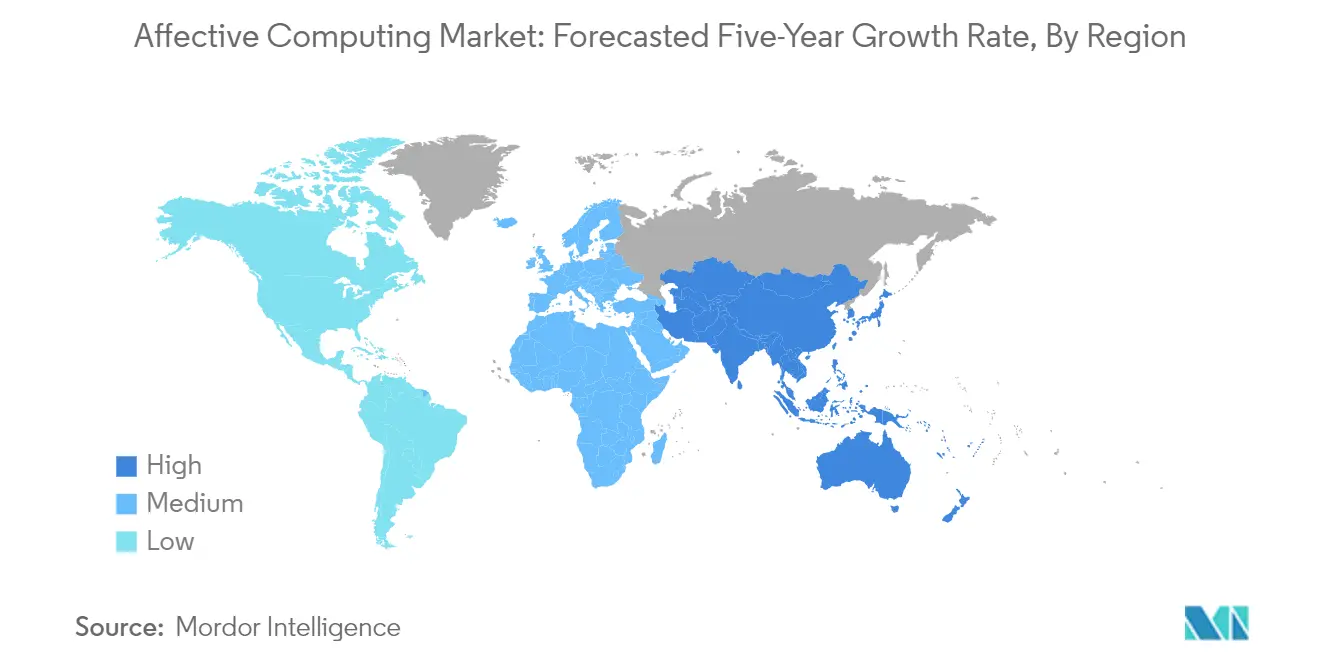
Affective Computing Market in Europe
Europe represents a significant market for affective computing solutions, demonstrating a robust growth rate of approximately 31% during the period 2019-2024. The region's market is particularly strong in countries like Germany, the United Kingdom, and France, where advanced automotive industries and healthcare sectors drive significant demand. The European market benefits from a supportive startup ecosystem that encourages innovation in affective computing and artificial intelligence domains. The region's stringent regulatory framework, particularly in automotive safety and data protection, has actually accelerated the adoption of sophisticated affective computing solutions. The presence of established research institutions and technology companies has created a fertile ground for developing advanced applications in facial recognition, gesture recognition, and emotional AI. The healthcare sector has been particularly progressive in adopting these technologies for patient care and monitoring. Furthermore, the region's strong focus on digital transformation across industries has created numerous opportunities for affective computing applications in various sectors.
Affective Computing Market in Asia Pacific
The Asia Pacific region represents one of the most dynamic markets for affective computing, projected to grow at an impressive rate of approximately 32% during the period 2024-2029. Countries like China, Japan, and India are emerging as major innovation hubs in the affective computing domain. The region's massive technological infrastructure development, particularly in countries like South Korea and Singapore, has created an ideal environment for affective computing applications. The presence of a large consumer base and rapidly digitalizing economies has attracted significant investments in this sector. The region's automotive industry has been particularly active in incorporating affective computing solutions for enhanced driver safety and vehicle automation. The healthcare sector is increasingly adopting these technologies for patient monitoring and care improvement. Additionally, the strong presence of manufacturing industries has created opportunities for implementing affective computing in industrial applications. The region's educational institutions and research centers are actively contributing to technological advancements in this field, particularly in the emotion recognition market.
Affective Computing Market in Rest of the World
The Rest of the World region, encompassing Latin America, the Middle East, and Africa, represents an emerging market for affective computing solutions with significant growth potential. While the penetration of affective computing services remains relatively lower compared to other regions, there is increasing adoption across various sectors. The region is witnessing growing implementation of automation and computing technologies across different industry verticals. Countries in the Middle East, particularly Israel, have developed a favorable startup ecosystem that is fostering innovation in affective computing. The availability of affective computing solutions in the Software as a Service (SaaS) model is helping overcome geographical barriers and accelerating adoption. Various sectors, including banking, gaming, and education, are increasingly deploying affective computing services for enhanced customer interaction. The region's efforts to diversify economies away from traditional sectors and the increasing demand for automation in enterprise applications are creating new opportunities for market growth, particularly in emotional robotics.
Affective Computing Industry Overview
Top Companies in Affective Computing Market
The affective computing market features established technology giants like IBM, Microsoft (through Nuance Communications), and Amazon Web Services, alongside specialized players like Affectiva, Element Human, and Realeyes Data Services. Companies are heavily investing in research and development to enhance their emotion recognition capabilities across various modalities, including facial, voice, and behavioral analysis. Strategic partnerships, particularly in the healthcare and automotive sectors, have become increasingly common as companies seek to expand their solution portfolios. Market leaders are focusing on cloud-based deployment models and API integration capabilities to provide scalable solutions. The industry has witnessed significant product innovation in areas such as driver monitoring systems, customer experience analytics, and healthcare applications, with companies developing proprietary algorithms and expanding their AI training datasets to improve accuracy and reliability.
Dynamic Market with Strong Growth Potential
The affective computing market structure is characterized by a mix of large technology conglomerates and specialized solution providers, with the latter focusing on specific industry verticals or technological capabilities. The market remains relatively fragmented, particularly in emerging application areas, with numerous startups driving innovation in specialized niches such as automotive safety systems and marketing analytics. Major technology companies are actively pursuing acquisitions of smaller, innovative firms to strengthen their market position and expand their technological capabilities, particularly in areas like computer vision and emotion AI companies.
The competitive dynamics are shaped by significant regional variations in market maturity and adoption rates, with North America leading in terms of technological advancement and market penetration. Companies are increasingly focusing on building comprehensive platforms that can integrate multiple emotion detection modalities rather than standalone solutions. The market has seen a notable trend of strategic partnerships between technology providers and industry-specific players, particularly in the healthcare, automotive, and retail sectors, to develop specialized applications and enhance market reach.
Innovation and Integration Drive Market Success
Success in the affective computing market increasingly depends on companies' ability to develop scalable, secure solutions that can be easily integrated into existing enterprise systems. Market leaders are focusing on building comprehensive ecosystems around their core technologies, including developer tools, APIs, and industry-specific solutions. The ability to provide robust data privacy and security measures, particularly in healthcare and financial services applications, has become a critical differentiator. Companies are also investing in expanding their geographic presence through local partnerships and customization of solutions for specific regional requirements.
For new entrants and smaller players, success lies in identifying and focusing on specific industry verticals or technological niches where they can build distinctive capabilities. The market presents significant opportunities for companies that can effectively address industry-specific challenges, such as regulatory compliance in healthcare or real-time processing requirements in automotive applications. Building strong partnerships with industry incumbents and technology integrators has become crucial for market expansion. Companies must also focus on developing solutions that can demonstrate clear ROI and practical applications while addressing privacy concerns and ethical considerations in emotion detection and analysis, including sentiment analysis and cognitive computing.
Affective Computing Market Leaders
-
Affectiva Inc.
-
IBM Corporation
-
Nuance Communications Inc.
-
Element Human Ltd
-
Kairos AR Inc.
- *Disclaimer: Major Players sorted in no particular order
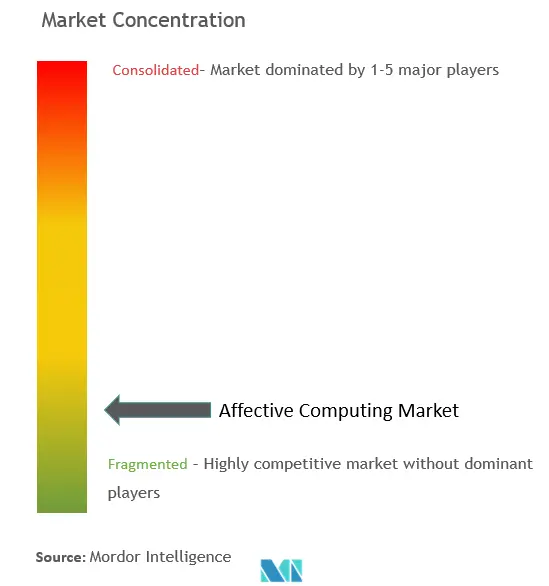
Affective Computing Market News
- June 2024: OMNIVISION Technologies has announced the launch of its new intelligent sensor designed to integrate presence detection, facial recognition, and always-on capabilities into a single, efficient solution. This innovative sensor aims to enhance the functionality and performance of a wide range of consumer and industrial applications, including laptops, tablets, and IoT devices.
- June 2024: Motion Gestures, a global firm in AI software specializing in hand tracking and gesture recognition with third-party cameras, announced today the successful closure of a USD 2 million pre-series A financing round, spearheaded by CCAA. With this latest round, Motion Gestures has successfully raised a total of USD 10 million since its inception, which notably includes USD 4.5 million in grants from the Canadian Government, specifically for AI-driven Computer Vision research.
Affective Computing Market Report - Table of Contents
1. INTRODUCTION
- 1.1 Study Assumptions and Market Definition
- 1.2 Scope of the Study
2. RESEARCH METHODOLOGY
3. EXECUTIVE SUMMARY
4. MARKET INSIGHTS
- 4.1 Market Overview
-
4.2 Industry Attractiveness - Porter's Five Forces Analysis
- 4.2.1 Bargaining Power of Suppliers
- 4.2.2 Bargaining Power of Consumers
- 4.2.3 Threat of New Entrants
- 4.2.4 Threat of Substitutes
- 4.2.5 Intensity of Competitive Rivalry
- 4.3 Assessment of the Impact of COVID-19 on the Market
5. MARKET DYNAMICS
-
5.1 Market Drivers
- 5.1.1 Increased Automation in Contact Centers
- 5.1.2 Increasing Adoption of Cloud-based Solutions and Online Solutions
- 5.1.3 Rising Technology Adoptions in Various Industries such as Automotive
-
5.2 Market Challenges
- 5.2.1 High Approval Times in Healthcare
- 5.2.2 Privacy and Security Concerns
6. TECHNOLOGY SNAPSHOT
- 6.1 Speech Recognition
- 6.2 Gesture Recognition
- 6.3 Facial Recognition
- 6.4 Other Types
7. MARKET SEGMENTATION
-
7.1 By Component
- 7.1.1 Hardware
- 7.1.1.1 Sensors
- 7.1.1.2 Cameras
- 7.1.1.3 Storage Devices and Processors
- 7.1.1.4 Other Components
- 7.1.2 Software
- 7.1.2.1 Analytics Software
- 7.1.2.2 Enterprise Software
- 7.1.2.3 Facial Recognition
- 7.1.2.4 Gesture Recognition
- 7.1.2.5 Speech Recognition
-
7.2 By End-user Industry
- 7.2.1 Healthcare
- 7.2.2 Automotive
- 7.2.3 Retail
- 7.2.4 Other End-user Industries
-
7.3 By Geography***
- 7.3.1 North America
- 7.3.2 Europe
- 7.3.3 Asia
- 7.3.4 Latin America
- 7.3.5 Middle East and Africa
8. COMPETITIVE LANDSCAPE
-
8.1 Company Profiles*
- 8.1.1 Affectiva Inc.
- 8.1.2 Element Human Ltd
- 8.1.3 Kairos AR Inc.
- 8.1.4 Nuance Communications Inc. (Microsoft Corporation)
- 8.1.5 IBM Corporation
- 8.1.6 Gesturetek Inc.
- 8.1.7 Nemesysco Ltd
- 8.1.8 Realeyes Data Services Ltd
- 8.1.9 audEERING GmbH
- 8.1.10 Eyesight Technologies Ltd
- 8.1.11 Emotibot Technologies Limited
- 8.1.12 Amazon Web Services Inc.
9. INVESTMENT ANALYSIS
10. MARKET OPPORTUNITIES AND FUTURE TRENDS
Affective Computing Industry Segmentation
Affective computing can be defined as the study of and creation of technologies for simulating, analyzing, and interpreting human emotions. The market for the study defines the revenues accrued from the sales of affective computing solutions across various end-users, including healthcare, automotive, retail, etc.
The affective computing market is segmented by component (hardware (sensors, cameras, storage devices, and processors), software (analytics software, enterprise software, facial recognition, gesture recognition, and speech recognition)), end-user industry (healthcare, automotive, and retail), and geography (North America, Europe, Asia-Pacific, and the rest of the world). The market sizes and forecasts are provided in terms of value (USD) for all the above segments.
| By Component | Hardware | Sensors | |
| Cameras | |||
| Storage Devices and Processors | |||
| Other Components | |||
| Software | Analytics Software | ||
| Enterprise Software | |||
| Facial Recognition | |||
| Gesture Recognition | |||
| Speech Recognition | |||
| By End-user Industry | Healthcare | ||
| Automotive | |||
| Retail | |||
| Other End-user Industries | |||
| By Geography*** | North America | ||
| Europe | |||
| Asia | |||
| Latin America | |||
| Middle East and Africa | |||
Affective Computing Market Research FAQs
How big is the Affective Computing Market?
The Affective Computing Market size is expected to reach USD 91.45 billion in 2025 and grow at a CAGR of 24.29% to reach USD 271.25 billion by 2030.
What is the current Affective Computing Market size?
In 2025, the Affective Computing Market size is expected to reach USD 91.45 billion.
Who are the key players in Affective Computing Market?
Affectiva Inc., IBM Corporation, Nuance Communications Inc., Element Human Ltd and Kairos AR Inc. are the major companies operating in the Affective Computing Market.
Which is the fastest growing region in Affective Computing Market?
Asia-Pacific is estimated to grow at the highest CAGR over the forecast period (2025-2030).
Which region has the biggest share in Affective Computing Market?
In 2025, the North America accounts for the largest market share in Affective Computing Market.
What years does this Affective Computing Market cover, and what was the market size in 2024?
In 2024, the Affective Computing Market size was estimated at USD 69.24 billion. The report covers the Affective Computing Market historical market size for years: 2019, 2020, 2021, 2022, 2023 and 2024. The report also forecasts the Affective Computing Market size for years: 2025, 2026, 2027, 2028, 2029 and 2030.
Our Best Selling Reports
Affective Computing Market Research
Mordor Intelligence offers extensive expertise in analyzing the rapidly evolving affective computing and emotion AI landscape. Our comprehensive research covers the convergence of cognitive computing and artificial emotional intelligence. We provide deep insights into technologies such as biometric sensing, gesture recognition, and facial expression recognition. The report extensively analyzes sentiment analysis trends and emotion detection systems. It also explores emerging emotional robotics applications, delivering crucial market intelligence through an easy-to-download report PDF format.
Stakeholders gain valuable insights into behavioral analytics implementations and emotional technology advancements. The report offers detailed coverage of multimodal emotion recognition systems and empathic computing solutions. Our analysis encompasses emotion sensing technologies, emotional analytics platforms, and innovative emotion recognition software. We examine the growing adoption of machine emotional intelligence across industries. This is supported by comprehensive affective computing market size data and trends in emotional intelligence technology, enabling informed decision-making for industry participants.




